100% Iraqi-made MBT?
There is a huge difference between producing an MBT from scratch and being an “assembler”. In between, there is license production, which requires much more advanced industrial capabilities, with perhaps reverse engineering on top of this. However, for propaganda purposes, it still useful for the morale of a population to say that a license production and assembly is the same as having a 100% indigenous-produced tank. This is the case with the Asad Babil, which was not only an assembly of a foreign tank, but also a mixed assembly of parts sold from abroad, and parts built locally (which were, as will become evident, beyond inferior quality). In short, the Asad Babil was an Iraqi clone of the Soviet T-72M export variant but cloned with inferior materials, tools, and technical know-how.The T-72M in Iraqi service
The Soviet T-72 was one of the best tanks in the world back in the 1970s. The introduction of the “Dolly Parton” composite frontal armor made it literally impregnable to the widely-used 105 mm guns on tanks fielded by NATO and SEATO nations, but also the 105 mm used by China. However, the T-72M, which was developed solely for export, was not as advanced. The T-72M was simply not as sophisticated as the standard, non-export model. Enormous technological gaps existed between the T-72, and other cheap and commonly exported tanks such as the revolutionary T-64 (which passed many technologies onto the T-72), and the affordable, but primitive, T-55. With the T-72M (nicknamed “Monkey” by western intelligence), the only way to achieve the best deal was to cut out as many technical features as engineers could, especially when targeting the Middle East and its export market. For that reason, the T-72M was, by all standards, a far downgraded T-72. As a result, the T-72M1 lacked a laser range finder, electronic ballistic computer, any kind of sensors, and was fitted with a “fresh-from-storage” 1960s-era night vision equipment. It had also no ATGM capabilities, and its autoloader was simplified and slower. There are also clues that its armor composition was far less refined than on the original T-72B. Nevertheless, Saddam Hussein ordered 100 of T-72M1s after the start of the Iran-Iraq War (1980-1988). 60 were lost in this war, but these were apparently up to the job, and Saddam asked for many more. Unfortunately, in 1989, the UN banned all arms exports to Iraq. This did, however, not prevent local production, thanks to Czech-built, Polish, and also, perhaps, Soviet T-72M1 parts smuggled through the embargo.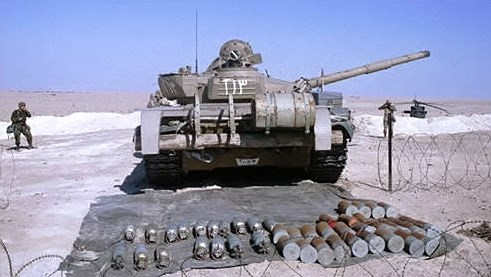
Abandoned T-72M1/Asad Babil in Iraq, 2003
The “Saddam” MBT
The first supposed all-Iraqi MBT was assembled with such parts in a German-built 1986 steel factory near Taji, north of Baghdad. The factory already had experience in refitting and overhauling badly damaged T-54/55s and T-62s. The first assembled T-72M was released in early 1989, and called “Saddam”, without notable changes compared to the regular T-72M1 but perhaps had lowered steel quality, some electronics omitted, and the fitting of an obsolete IR searchlight. More significantly, the Saddams were downgraded for desert warfare, as some of the suspension’s shock absorbers were removed. However, this production was not to last. Following the Iraqi invasion of Kuwait in 1990, a new UN embargo, far more strict, was passed, which banned everything but the smallest supply parts to maintain existing Iraqi tanks. Critical parts were missing for the completion of the last batches of Saddams. However, according to Russian intelligence, at least 100 tanks (250, according to other sources) were nevertheless assembled, with ever more concessions, and delivered in the meantime, or after the embargo, which tells about the quality of these deliveries. These even poorer quality tanks were the Asad Babil tanks.Design of the “Lion of Babylon” MBT
In short, the Asad Babil was a rushed and cheap downgrade of the already downgraded Saddam MBT, itself derived from the downgraded T-72M export model. Externally, these are difficult to separate from the regular Saddam/T-72Ms, but the local “upgrades” consisted of 30 mm cast armor plates or frail quality forged from mild steel (no longer laminated RHA), bolted-on the glacis armor plate, leaving, in theory, an equivalent air gap in between to dissipate a HEAT (High Explosive Anti-Tank) jet. Another appliqué armor plate was also added to the rear. The Asad Babil’s side armor had 60 mm protection, 300 mm for the turret, and the flat rear was 45 mm thick.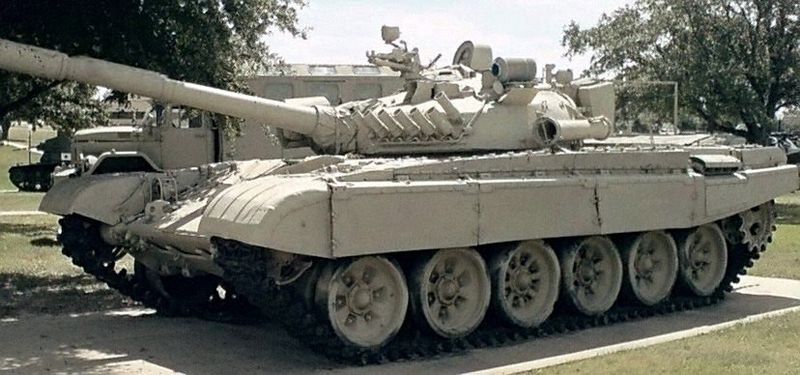 In addition, rubber skirts of local manufacture were also added. All the electronics left were removed except for a few still fitted to the laser rangefinder. Like the “Saddam”, a local-built searchlight was added on the right-hand-side. According to US intelligence, however, a few were equipped with Belgian-made thermal sights. There are also arguments about a better track protection against sand and mud, thus allowing to reduce the numbers of shock absorbers. However, due to the lack of IR searchlights, they were fitted with white lights projectors, missing all but the more elementary night vision equipment.
In addition, rubber skirts of local manufacture were also added. All the electronics left were removed except for a few still fitted to the laser rangefinder. Like the “Saddam”, a local-built searchlight was added on the right-hand-side. According to US intelligence, however, a few were equipped with Belgian-made thermal sights. There are also arguments about a better track protection against sand and mud, thus allowing to reduce the numbers of shock absorbers. However, due to the lack of IR searchlights, they were fitted with white lights projectors, missing all but the more elementary night vision equipment.The ammunition, too, was apparently downgraded or local production shells. It is indeed believed but not confirmed that the Russians sold APDS shells with mild steel core instead of tungsten alloy, rendering them completely useless. Outside the regular 125 mm smoothbore gun, the Asad Babil was equipped with the regular 12.7 mm heavy DShK heavy MG, and a coaxial PKT LMG. Some of the tanks were also seen with an electro-optical interference pod of Chinese origin, which proved useless in combat. The armor “upgrades” seem to have been relatively effective against Iranian TOWs and Hellfire missiles on the Saddams, but left the Asad Babils virtually defenseless against most modern 120 mm shells.
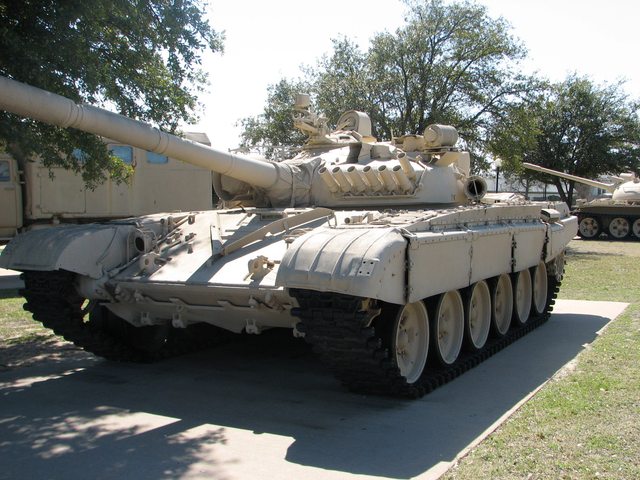
Active service
In all, Iraq had about 1000 T-72s, M, M1, and the locally assembled Saddams and Asad Babils on the eve of the invasion of Kuwait. After 2003, their numbers had dwindled to 375, and only 125 are listed in the new Iraqi Army, but they about to be pushed to the scrapyard or used for target practice. There are no detailed records of the use of the Asad Babil in the Iran-Iraq War. The Asad Babil first saw service in the First Gulf War (1990-1991), with the Republican Guard divisions and the sole Saladin division. They were mainly employed as armored self-propelled artillery, but when they did fight against coalition forces directly, they fared poorly against American main battle tanks and IFVs. The standard-issue 120 mm DU core APFSDS round supplied to all M1 Abrams had an effective reach at 3,000 m, whilst the Iraqi tungsten-core 125 mm equivalent effective range was only 1,800 m. It was demonstrated at the Battle of Norfolk, where Asad Babils were butchered with ease by Bradleys IFVs. M60s also had no difficulties to knock-out Lions with their APFSDS 105 mm rounds as shown in 1991 at the Battle of Kuwait airport.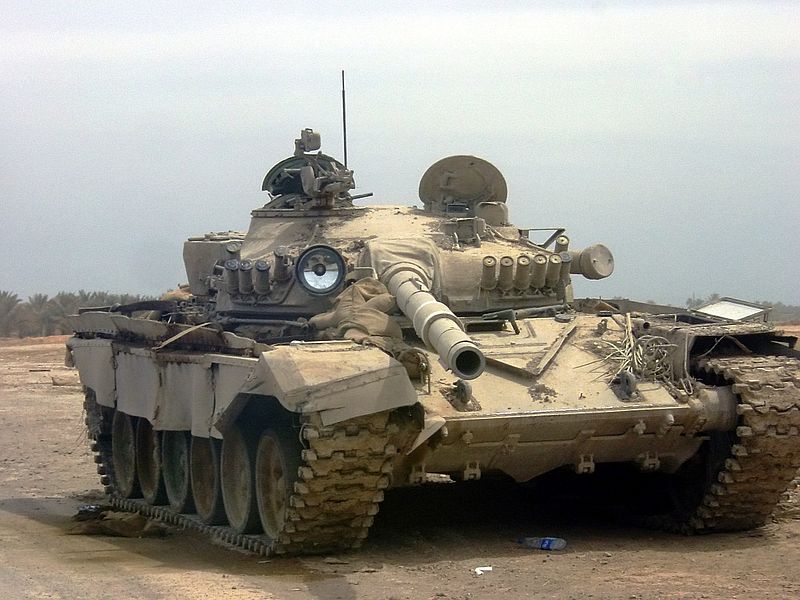 There is only the exception of the Battle of Phase Line Bullet, February 26, 1991, to put some credit on the Asad Babil. Bradleys from the 4th squadron, 7th Cavalry Regiment were driven back by dug-in Iraqi T-72Ms and Asad Babils of the Tawakalna Division, after a very close range engagement of almost two hours in very poor visibility. Friendly fire cost the Americans more than Iraqi tanks, but according to Atkinson and Scales, the Asad Babils’ only success in the battle was the destruction of two M2 Bradleys, and several other damaged.
There is only the exception of the Battle of Phase Line Bullet, February 26, 1991, to put some credit on the Asad Babil. Bradleys from the 4th squadron, 7th Cavalry Regiment were driven back by dug-in Iraqi T-72Ms and Asad Babils of the Tawakalna Division, after a very close range engagement of almost two hours in very poor visibility. Friendly fire cost the Americans more than Iraqi tanks, but according to Atkinson and Scales, the Asad Babils’ only success in the battle was the destruction of two M2 Bradleys, and several other damaged.By 1991, and again in 2003, all encounters with the Asad Babil tended to result in uncontested kills, but there is evidence of at least one Asad Babil surviving a direct hit from an Abrams HEAT round in Mahmoudiyah, in 2003. The shell impacted the front of the turret at point blank range, apparently without too much damage. According to Polish sources, some Asad Babils may have been fitted with ERA in 2003, thus accounting for this combat report. It is not known for certain if Asad Babils received upgrades in between the First Gulf War and Iraq War, but seeing the result of engagements this time, it is dubious if they did.
In the 2003 Iraq War, the Republican Guard Medina Division’s Asad Babils were deployed around Baghdad as a last-ditch defense. These were engaged by US tanks from just 50 yards, and seven Iraqi T-72s were destroyed without any coalition losses. Intelligence services stated that this was explained both by poor marksmanship of the crews of the Asad Babils and their lack of modern fire control systems. Needless to say, the absence of modern electronics obliged not only the driver to stop for firing, but also because of seasoned gunners, which became rare after the bloodbath of the Iran-Iraq War and Gulf War. Only one Bradley was disabled by a 125 mm round from an Asad Babil in the 2003 War in Iraq, in an ambush near Baghdad airport. Perhaps only one Abrams, hit three times in the turret, was extensively repaired, but was not considered a kill for an Asad Babil.
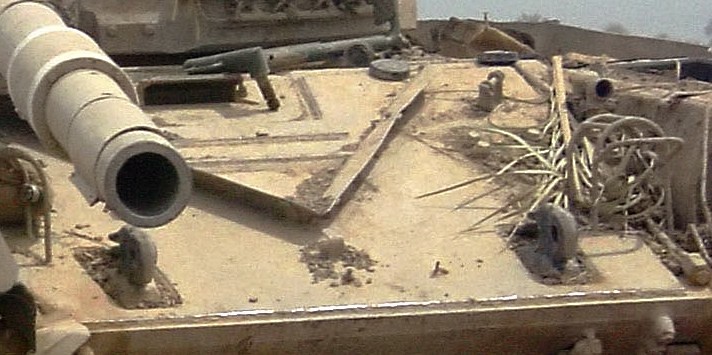
Conclusion
Iraq, under Saddam’s rule, seemed to prefer numbers and appearance in parades than effectiveness on the battlefield. A clue was that Type 59s, cheaper and downgraded compared to T-54As, constituted the bulk of the Iraqi forces. By watering down, two times, an already downgraded MBT, the Iraqis only succeeded to give their best units a tank that was technologically at least 20 years out of date. Most were abandoned by their crews after the fall of Baghdad in 2003, and later scrapped by U.S. Army disposal teams or used for target practice back in the USA. The new Iraqi Government will acquire dozens of refitted T-72M1s from Hungary for a full armored brigade, located in Taji for easy maintenance. Surviving Iraqi officers indeed were instrumental in this choice. The Asad Babil was largely Saddam’s doing and would remain one of the worst tanks ever built in history.
Asad Babil specifications |
|
| Dimensions : | 6.52oa/6.95 x 3.59 x 2.23 (22.1 x 11.9 x 7.4 fts) |
| Total weight, battle ready | 41,5 tons (91.490 lbs) |
| Crew | 4 (commander, driver, gunner, loader). |
| Propulsion | V-12 diesel 780 hp (582 kw) 18hp/ton |
| Speed | 60/45 km/h road/cross-country (37/28 mph) |
| Range/consumption | 425 km (264 mi) extended to 600 with external drums |
| Armament | One 125 mm sb (4.92 in) gun Coaxial 7.62 mm PKT (0.3 in) light machine-gun Cupola mounted DsHk 12.7 mm (0.5 in) AA heavy machine-gun |
| Armor | Turret front 300 mm, glacis 300+20 mm max (11.8 in) |
| Ammunition used | HE, HEAT, HESH, APFSDS |
| Total production | Unknown |
Links
The Asad Babil MBT on WikipediaWorst tanks ever made
 Iraqi T-72M, during the Iran-Iraq War. 1980-1988.
Iraqi T-72M, during the Iran-Iraq War. 1980-1988.
 T-72M1 deployed in Kurdistan, 1995.
T-72M1 deployed in Kurdistan, 1995.
 Iraqi Republican Guards Asad Babil, in 1990.
Iraqi Republican Guards Asad Babil, in 1990.
 Unmarked Asad Babil, possibly from the Tawakalna Division, in 2003. Notice the mix of roadwheels.
Unmarked Asad Babil, possibly from the Tawakalna Division, in 2003. Notice the mix of roadwheels.
